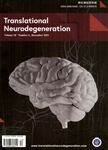Development of stem cell-based therapy for Parkinson’s disease
作者机构:Centre for Stem Cells and Regenerative MedicineThe Liaocheng People’s Hospital/Affiliated Liaocheng HospitalTaishan Medical UniversityShandong 252000China
出 版 物:《Translational Neurodegeneration》 (转化神经变性病(英文))
年 卷 期:2015年第4卷第1期
页 面:120-132页
核心收录:
学科分类:0710[理学-生物学] 0402[教育学-心理学(可授教育学、理学学位)] 1002[医学-临床医学] 1001[医学-基础医学(可授医学、理学学位)] 1010[医学-医学技术(可授医学、理学学位)] 1009[医学-特种医学] 10[医学]
基 金:by National Natural Science Foundation of China(NSFC 81271251) The Science and Technology Developmental Fund of Shandong Province,China(2012GGA15049)
主 题:Parkinson’s disease Dopamine neuron Neural stem cell Human embryonic stem cells Induced pluripotent stem cell Induced dopamine neuron
摘 要:Parkinson’s disease(PD)is one of the most common neurodegenerative disorders of aging,characterized by the degeneration of dopamine neurons(DA neurons)in the substantial nigra,leading to the advent of both motor symptoms and non-motor *** treatments include electrical stimulation of the affected brain areas and dopamine replacement *** though both categories are effective in treating PD patients,the disease progression cannot be *** research advance into cell therapies provides exciting potential for the treatment of *** cell sources include neural stem cells(NSCs)from fetal brain tissues,human embryonic stem cells(hESCs),induced pluripotent stem cells(iPSCs)and directly induced dopamine neurons(iDA neurons).Here,we evaluate the research progress in different cell sources with a focus on using iPSCs as a valuable source and propose key challenges for developing cells suitable for large-scale clinical applications in the treatment of PD.



